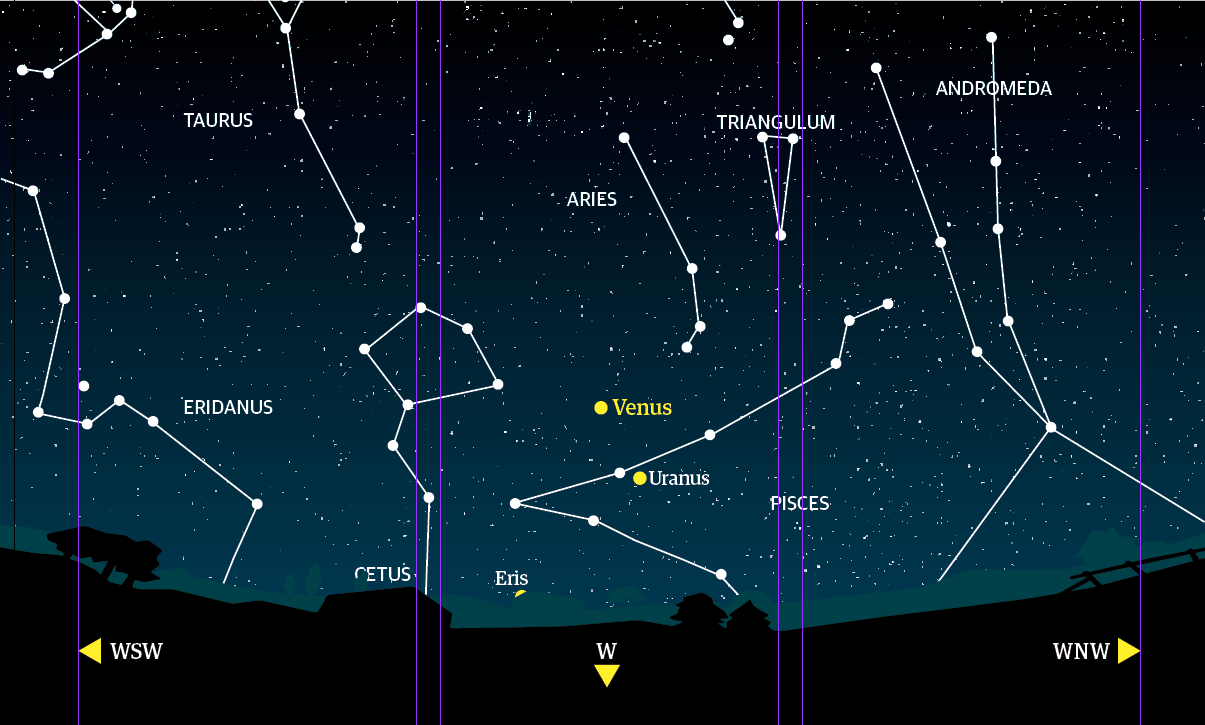April Night Sky: This month’s planets
Venus remains the star of the evening skies, while Saturn and Mars keep close company in the morning
VENUS (20:00 BST on 1 Apri)l

Constellation: Aries moving into Taurus
Magnitude: -3.9
AM/PM: PM
Venus will return to the sky in April as a beautiful “Evening Star,” bright enough to dominate the sky after sunset and draw the eye away from everything else. Not only that, but it will be in a part of the sky rich with star clusters, and will have a spectacular close encounter with the young Moon mid-month.
At the start of April Venus will be relatively low in the west after sunset, but with each day that passes it will climb a little further away from the Sun, improving its visibility until it is setting more than three hours after the Sun. To see Venus at its best you’ll want to be somewhere with a clear view to the west, as your viewing won’t be cut short by the planet disappearing behind trees, a hill or buildings. It will be immediately obvious to the naked eye, but if you have a telescope it will show you Venus as a bright, gibbous disc.
On 17 April, a beautiful, crescent Moon will be shining below and to the left of Venus. By the next evening the Moon will shine to the planet’s upper left, and you should see the subtle lavender glow of Earthshine illuminating the dark part of the Moon’s disc. After sunset on the 19th the Moon will have climbed further away to Venus’ upper left, but they will still be a stunning sight together in the twilight.
In late April Venus will appear to drift up towards, and then pass, the famous Pleiades star cluster. On the evening of 24 April the planet and cluster will be just under three-and-a-half-degrees apart. This celestial fly-by will look particularly pretty through binoculars. Venus will then slide up between the Pleiades and the nearby V-shaped Hyades cluster. Look for Venus shining alongside the Hyades’ brightest star, red-hued Aldebaran, on the 27 April.
Venus is often called “Earth’s Twin” because it is roughly the same size, but the similarities end there. Earth is an oasis compared to the furnace-hot nightmare world of Venus. Venus is thought of by many planetary scientists as the forgotten planet; although a handful of space probes have been sent there, and other space agencies have studied it, other planets, notably Mars, tend to get more attention paid to them by NASA. Lots of missions to study Venus have been proposed over the years, but none have been approved. This is a great shame, because not only is Venus a fascinating planet in its own right, but studying its climate and weather in the same depth other missions have studied Mars and Saturn would tell us a lot about global warming and atmospheric science, which might help us combat climate change here on Earth.
MERCURY (22:00 BST on 24 April)

Constellation: Pisces
Magnitude: 1.2
AM/PM: AM
The closest planet to the Sun will be so close to it in the morning sky this month that it will be almost impossible to see. If you are determined to try and find it you’ll need to be scanning the eastern sky around half an hour before sunrise, preferably using a pair of binoculars. To prevent injuring your eyes, be sure to stop before sunrise.
MARS (04:00 BST on 07 April)

Constellation: Sagittarius
Magnitude: 0.3 brightening to -0.3
AM/PM: AM
Mars will stay low in the sky this month. At the start of the month Mars will be very close to Saturn – just three Moon widths from it before dawn on April Fool’s Day – but as the days pass they will move apart. Look for the waning gibbous Moon close to Mars and Saturn before dawn on 7 April, and to their left the next day.
JUPITER (22:00 BST on 24 April)

Constellation: Libra
Magnitude: -2.4
AM/PM: AM
The morning sky belongs to Jupiter this month. Strictly speaking the largest planet in the Solar System is an evening object, because at the start of the month it rises before midnight, and by month’s end rises before 10pm, but it will be at its best in the early hours. Shining at magnitude -2.4, the planet will easily be the brightest thing in the sky until sunrise. To Jupiter’s lower left you’ll see the planets Saturn and Mars huddling close together, but neither will come close to Jupiter in terms of brightness or beauty. Look for the Moon shining to Jupiter’s upper right on 3 April and to its upper left the next morning.
SATURN (04:00 BST on 07 April)

Constellation: Sagittarius
Magnitude: 0.5
AM/PM: AM
Saturn is visible in the morning sky throughout the month, keeping brighter, redder Mars company low above the southern horizon until morning twilight. Make sure to look out for the Moon shining close to Saturn before dawn on the morning of 7 April, when they’ll be just over four degrees apart.
URANUS (19:00 BST on 16 April)

Constellation: Pisces
Magnitude: 5.9
AM/PM: PM
Although Uranus will be above the western horizon after sunset this month, it will not be visible because it will be too close to the Sun. Unlike bright planets such as Venus and Jupiter, Uranus is so faint that its weak light is overwhelmed by a bright background sky, and this month it will be setting barely an hour after the Sun.
Keep up to date with the latest reviews in All About Space – available every month for just £4.99. Alternatively you can subscribe here for a fraction of the price!




